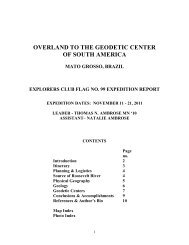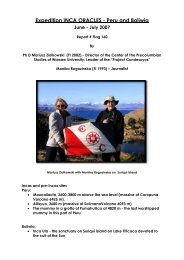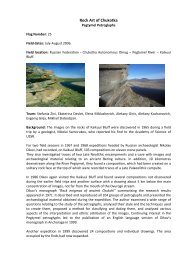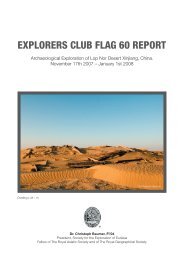the explorers journal - The Explorers Club
the explorers journal - The Explorers Club
the explorers journal - The Explorers Club
Create successful ePaper yourself
Turn your PDF publications into a flip-book with our unique Google optimized e-Paper software.
centuries in a coach seat. And keep in mind that<br />
this is <strong>the</strong> nearest o<strong>the</strong>r star. To reach any stellar<br />
system with life might require a trip ten times<br />
longer or more.<br />
Could we beat this rap One possibility would<br />
be simply to accept that going to o<strong>the</strong>r suns is like<br />
Bolero—slow and soporific—and we’ll have to put<br />
<strong>the</strong> crew into suspended animation until shortly<br />
before arrival. <strong>The</strong> evident problem with this idea<br />
is that we don’t know how to successfully suspend<br />
<strong>the</strong> animation of anyone, despite what you<br />
see in <strong>the</strong> movies.<br />
A second possibility is to somehow construct<br />
a spacecraft that could cruise near <strong>the</strong> speed of<br />
light. This would greatly reduce<br />
<strong>the</strong> perceived travel time<br />
for <strong>the</strong> crew, thanks to special<br />
relativity. However, this approach<br />
runs afoul of some<br />
simple physics. Consider<br />
revving up a rocket—no bigger<br />
than <strong>the</strong> Saturn V that<br />
took men to <strong>the</strong> Moon—to 90<br />
percent <strong>the</strong> speed of light.<br />
<strong>The</strong> energy required is greater<br />
than <strong>the</strong> United States has<br />
consumed since its birth in<br />
1776. That’s a lot of fuel.<br />
In addition, barreling<br />
through space at such a velocity<br />
would turn grains of interstellar<br />
dust into deadly missiles. <strong>The</strong>se o<strong>the</strong>rwise<br />
innocuous bits of carbon would knife <strong>the</strong> length of<br />
<strong>the</strong> spacecraft in less than a millionth of a second,<br />
slicing and dicing <strong>the</strong> passengers en route.<br />
It seems that rocketing to <strong>the</strong> stars might be<br />
less than gratifying. But surely <strong>the</strong>re’s warp drive<br />
in our future After all, conventional rockets are so<br />
twentieth century.<br />
Well, it’s true that several inventive schemes<br />
have been proposed to bend space in such a<br />
way that our craft could take a shortcut from one<br />
part of <strong>the</strong> cosmos to <strong>the</strong> o<strong>the</strong>r, reaching distant<br />
destinations in no time flat. <strong>The</strong>se distortions of<br />
space and time are commonly called wormholes.<br />
But while wormholes described on blackboards<br />
often look promising, it’s unclear <strong>the</strong>y will ever<br />
work in real life.<br />
<strong>The</strong> bottom line is simple: interstellar rocketry,<br />
while an established trope of science fiction, may<br />
be as much a pipe dream as fat-free doughnuts or<br />
34<br />
world peace.<br />
So what does this mean Will our ken ever<br />
extend beyond our cosmic front porch Is it hopeless<br />
to think that we might someday commune<br />
with o<strong>the</strong>r inhabitants of <strong>the</strong> galaxy, assuming<br />
such beings exist<br />
Some scientists think <strong>the</strong>re’s hope aplenty.<br />
It takes <strong>the</strong> form of a straightforward experiment<br />
called SETI, <strong>the</strong> Search for Extraterrestrial<br />
Intelligence. <strong>The</strong> idea is to aim large radio antennas<br />
at nearby star systems, and pick up broadcasts<br />
from o<strong>the</strong>r worlds. Detecting a signal beamed<br />
from space would be compelling evidence that<br />
somebody’s out <strong>the</strong>re, and allow us to learn about<br />
extraterrestrial sentients without<br />
fretting about ei<strong>the</strong>r highspeed<br />
rockets or wormholes.<br />
SETI is well known to many,<br />
being <strong>the</strong> subject of <strong>the</strong> popular<br />
movie Contact (based on<br />
<strong>the</strong> 1983 Carl Sagan novel of<br />
<strong>the</strong> same name). In <strong>the</strong> film,<br />
Jodie Foster—commanding an<br />
array of large antennas—dons<br />
a pair of headphones, tunes<br />
her receiver, and soon picks<br />
up an alien radio signal.<br />
Unfortunately, real-life<br />
SETI has failed to duplicate<br />
Foster’s success, despite 50<br />
years of listening.<br />
Indeed, given <strong>the</strong> length of time SETI researchers<br />
have been probing <strong>the</strong> skies, some people<br />
question whe<strong>the</strong>r this effort is worth <strong>the</strong> candle.<br />
After all, in a lifetime of surveillance, this project<br />
has yet to uncover a single peep from <strong>the</strong> cosmos.<br />
Could it be that <strong>the</strong>re simply aren’t any aliens <strong>The</strong><br />
universe, which astronomers know is desperately<br />
sparse, bitterly cold, and implacably hostile, might<br />
also be sterile—or at least bereft of <strong>the</strong> sort of selfaware<br />
biology that would amuse us in conversation.<br />
If we concluding that Homo sapiens is creation’s<br />
brightest bulb, this too would be ungratifying, unwarranted,<br />
and a bit self-serving. Despite <strong>the</strong> length<br />
of SETI’s search, its breadth has been shallow. This<br />
is a simple consequence of <strong>the</strong> lack of resources.<br />
A substantial NASA effort to make a systematic<br />
search, an enterprise that cost American taxpayers<br />
less than a nickel a year, was killed by Congress<br />
in <strong>the</strong> early 1990s, just as <strong>the</strong> NASA equipment<br />
was warming up. Since <strong>the</strong>n, SETI has been a<br />
Lakes of natural gas pool on Saturn’s moon Titan. Could <strong>the</strong>re be slow-moving, organic life in <strong>the</strong>se bodies of liquid Image courtesy Cassini Radar Mapper/JPL/ESA/NASA.
















